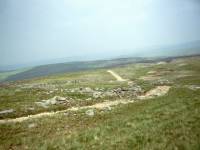Eric Ravilious (1903-42) is known for his watercolour landscapes of southern England, particularly those featuring the chalk figures of the South Downs. He painted the stark figure of the Long Man of Wilmington, which we can see in its other-worldly dimensions through a barbed wire fence. There is something idealistic about the painting, like an illustration from a children’s book, but this is undermined by the wire and overcast sky. The English landscape is tamed and parcelled but not completely. The figure, whose mystery is unsolved, remains unperturbed on the billowing downs, a connection with the past, reaching back through time.
Theories about the Long Man of Wilmington range from pre-historic fertility symbol to early 18th century folly. Ravilious viewed it as a female figure opening the doors of death.











